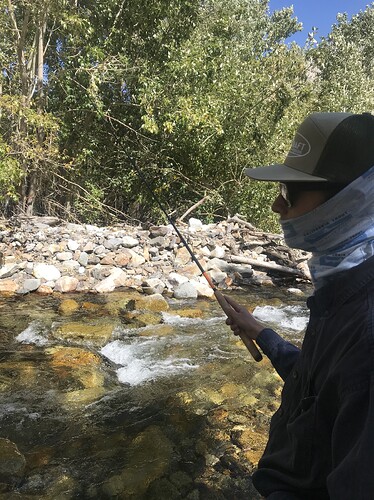A Mild Mizuchi Rod Disappointment
As the new kid on this board, I had to think long and hard about how I was going to say that I was mildly disappointed with the Mizuchi rod, because it has gotten so much positive praise on this board. So I believe that the right place to begin with this is in defining just what a small stream really is, which may very a lot according to where you happen to live and fish.
For me a small stream is a thin blue line on a Topographic map. Something that you can often step over or jump across. Certainly not the kind of place where you need to or could cast 6 meter or 8 meter long lines. A stream with conifer and broad leaf trees growing on each bank that have limbs that often grow together over the water, and hopefully, above your head. The kind of stream where the water flow forms an alley of open water running down between two brushy banks, and the only way to fish it is for you to get in the water and wet wade upstream on the left side if you are right handed, tight to the brush, so you have enough room to cast sidearm to help keep your line out of the trout’s cone of vision. The kind of stream where you fish a line that is two feet shorter than your rod is long, so you can make Bow-And-Arrow casts into tight spots without having to move the rod. The kind of streams where there is often no back casting room at all. In other words, a very challenging fishing environment that requires a super short rod to be able to fish water that most other fly fishermen would never consider fishing.
In Tom Davis’ introduction to the Mizuchi rod, he stated that rods of 2.4 meters and shorter do not cast well in his hand, and probably could not be designed to do so. I am probably the only angler here who owns both the Esoteric 206/245 and the Mizuchi 240/290/340 rods, and I can assure you that the 206/245 is one sweet casting rod. Please read the Jason Klass review of the 206/245, and the comments below it of other anglers’ comments who have cast and fished the 206/245: Tenkara Zoom Rod | Tenkara Talk
There is a favorite, exceedingly tight, small stream that I really love to fish, which my first tenkara rod was much too long to fish there - the 12 Ft. Iwana. I went to a Diawa 27SR Soykaze rod next, (and I really love that rod and still have it) but it was still too long for that stream and many others like it. Then a Shimotsuke Kiyotaki 24 rod was tried, which was a big improvement on tight streams and kind of like fishing with a string and a dowel. Then a Kiyotaki 18 rod came next, and both Kiyotakis worked great for the Bow-And-Arrow Casts, but left a lot to be desired in normal casting. I caught a lot of trout on them both, but I eventually gave them away. The 206/245 worked out to be the best rod for me for really tight small streams, and it casts beautifully at both lengths. It is a 14 and 15.5 Penny Rod. The Penny ratings are an indication of relative rod power, but do nothing to indicate anything about a rod’s casting action - fast, medium or slow. In other words, a Tip Casting rod action, a Mid-Section casting rod action, or a Full-Flex rod casting action.
The Mizuchi Rod has Penny ratings of 16 Pennies @ 24, 17 Pennies @ 29 and 18 Pennies @ 34 CMs, which makes it a fast rod at 24, and a more moderate casting rod at its two longer lengths. I like its casting qualities best at its longest and second longest lengths. I found it to be similar to the Kiyotakis at its shortest length, and not nearly as nice to cast as the 245/206 rod is. Both rods handle the Bow-And-Arrow Casts well, with the 206/245 not giving up all that much in the rod power department to the Mizuchi. The 206/245 weighs 1.9 Oz. compared to the Mixuchi’s 2.86 Ozs.
,
I own two other 33 length rods - the Suntech Kurenai HM33, and a Nissin Royal Stage 330. The penny ratings for those two rods, respectively, are 9 and 8 Pennies. The Kurenai is a tip casting rod, while the Royal Stage is more moderate in its casting action. Both rods weigh the same: 1.5 Ozs. The Mizuchi weighs in at 2.86 Ozs. all without the tip caps. Of course this is an apples to oranges comparison, undoubtedly the Mizuchi is a much more powerful and durable rod. Casting all of these rods with the same #3 Level FC lines, 5, 7, 9, 11 and 13 feet long (not counting the tippet lengths), the 33s feel like you are driving a sports car. While the 34 Mizuchi ZX feels like you are driving a Jeep Wrangler. Jeeps are very good at doing what they are designed to do, but the trout that live in most small streams are of pretty modest in size and easily handled on rods that make them more challenging to catch. I am quite sure everyone who has bought a Mizuchi will be well pleased with their purchases and catch a lot of fish quite happily on them. Like I said, I was only mildly disappointed with mine…. T-stillwater.
